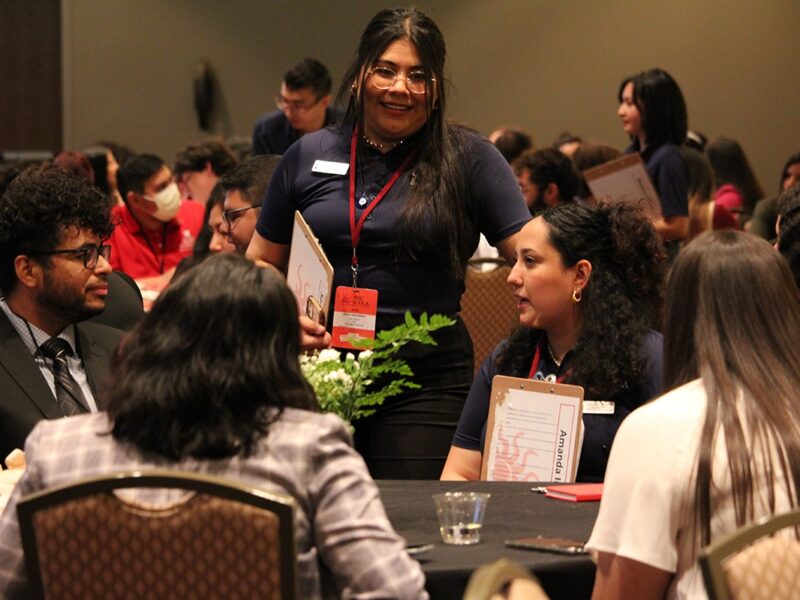Anne Black: Dedicated To The Arts And To Texas A&M
 When people think of OPAS at Texas A&M, they just naturally think of its executive director Anne Black and her talent for bringing some of the world’s best performers to the university and the Bryan/College Station community. That is saying a lot, especially since College Station is not exactly the center of the performing arts world.
When people think of OPAS at Texas A&M, they just naturally think of its executive director Anne Black and her talent for bringing some of the world’s best performers to the university and the Bryan/College Station community. That is saying a lot, especially since College Station is not exactly the center of the performing arts world.
Black has been with OPAS for 26 of the organization’s 38 seasons, and she says Texas A&M’s place in the performing arts arena has changed over time. From modest beginnings, Black and a group of dedicated supporters, including students, have helped OPAS continue to develop into a world-class program and that brings artists of national and international prestige to Texas A&M. They include Van Cliburn, Itzhak Perlman, Marcel Marceau, the Chicago Symphony, Rudolf Nureyev, Mikhail Baryshnikov and Yo-Yo Ma, just to name a few. Broadway and dance have also been a large part of the programming efforts of OPAS, including national tours of Cats, Les Miserables, the Bolshoi Ballet and others.
The Opera and Performing Arts Society, a committee of Texas A&M’s Memorial Student Center now known simply as MSC OPAS, was founded in 1972 in the hope that the opening of the Rudder Theater Complex in 1973 would begin an era of cultural presentations during the celebration of Texas A&M’s 100th anniversary in 1975-76. Black says the group of dedicated citizens, now known as charter members of OPAS, got together under the leadership of the late J. Wayne Stark, director of the Memorial Student Center at that time. Texas A&M students were among the earliest supporters and workers.
Black says when she first came to OPAS, artists were largely booked in blocks – if they were playing Houston, Dallas or Austin, they were considered for College Station.
“We booked the Houston Ballet every spring to close the season and when the Wortham Center was built in the late 1980s, the Houston Ballet no longer wanted to do run-outs,” she recalls. “In 1988 they told us they would not come for less than three nights and the program would be the same all three nights. That was not feasible for us in those days, so we began to look beyond the boundaries of what had been done for the first 15 years.”
Since she became director, OPAS has evolved from five or six one-night programs to 12 or 14 multiple performance programs, which include three series – Main Stage, Intimate Gatherings and OPAS JR for younger audiences.
“We are now considered a major regional performing arts market,” Black notes. “Our reach is considerable, as we are at least 90 miles from any of the other major markets (Houston, Dallas, Austin, San Antonio).”
In addition to the performance programs, an educational component and artist residency activities have been added. “We try to serve a very broad audience base, which includes families. Each season, one of the main focuses of the program committee is to make sure there is something for everyone,” Black says.
“Our total budget was about $300,000 when I came in 1984 and it is now $2.5 million,” she adds. More than 85 percent of that comes from ticket sales, contributions, sponsorships, advertising and interest from an endowment. Approximately 15 percent comes from student service fees.
“OPAS is a committee of the Memorial Student Center Student Programs. This is the reason you see a lot of half-price specials, rush tickets and other discounts targeted only to Texas A&M students,” Black explains.
Another significant change is the sophistication of the student audience. For many years, Black says OPAS gave students at Texas A&M their first experience of live performing arts. Now, they come to Texas A&M as experienced travelers who have seen the best of theatre, music and dance in London, New York and many other places.
When asked how she goes about getting some of these world-famous performances and performers to come to Texas A&M, Black says OPAS does audience surveys to find out what programs are high on their list and then “we go after them.”
“This is a very challenging six-to-18-month process, which takes into account the surveys, past sales, university calendar, athletic schedules and the ever-increasing demand upon the Rudder facilities,” she adds.
In that process, Black says she has been fortunate to meet many artists, both here and around the country. Among her favorites are Yo-Yo Ma, Rudolf Nureyev, Frederica Von Stade and Bob Hope. She says that one of the most special evenings, both on and off the stage, was the performance by Rudolf Nureyev and the Paris Opera Ballet.
“We had heard horror stories about him and his temper, so we were prepared for the worst,” she says. “He danced a long program (he was 50 years old at the time), then stood and signed autographs for our season subscribers for more than an hour, then attended a midnight dinner for our donors. At 3 a.m. we suggested it was time to go home! He was very generous with the many fans that came to see him dance.”
Black says it’s the friendliness of Aggieland that helps draw these performers here. “It is the reason we were chosen for the world premiere of the Bolshoi Grigorovich Company in 1990. They visited 37 venues around the country and chose us, primarily because of the warm welcome they got on this campus,” she adds.
Black’s leadership and commitment to excellence have brought the performing arts world to Texas A&M where artists are welcomed with warmth and enthusiasm. Black says she frequently gets letters from artists and managers complimenting her and the Rudder Complex staff for their competent, courteous professionalism. “Overall, the artists have a good experience when they come here,” she says. Black, OPAS and the Rudder Complex staff make sure of it.
For information on the current season, see http://opas.tamu.edu/.





